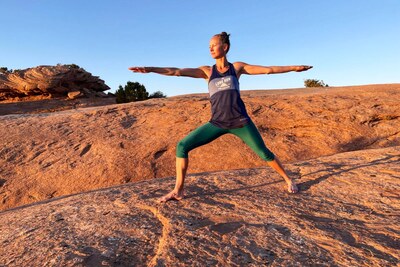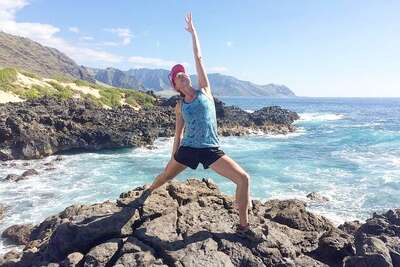Yoga can play an important supporting role for athletes in the thick of training, racing and recovering. Not only do the physical poses and asanas (i.e. postures) help with strength, flexibility, mobility and recovery, but the non-physical aspects of yoga can allow athletes to find moments of calmness, clarity and rest within the usual business of a packed calendar...
Should you use yoga?
If you're not familiar with yoga, it originated in northern India thousands of years ago and is a holistic method for connecting the body, mind, breath and emotions into a more peaceful state of being. The word yoga itself translates 'to unite'.
Further benefits of yoga include injury prevention, enhanced performance, burnout prevention, and it can help your longevity in sport.
Additionally, yoga can provide a balance to the constant consideration of time, race splits and mileage, which engulfs many athletes. Using running as an example, yoga teacher Sage Rountree writes:
While running involves doing, pushing, working, a yoga asana practice is often about being, yielding, resting. But both require and develop the athlete’s intuition about when and how much to strive, when and how much to surrender.
How to add yoga to your training plan
Naturally, many athletes start trying yoga to explore the physical side of postures and poses, so let’s begin there.
When I took my very first hatha yoga class in northern England as a keen teenager and serious cross-country runner, I couldn't believe that my arms were shaking in downward dog; I thought I was strong?!

Of course, this new, curious challenge drew me back for more. The classes provided a welcome break from competitive training and racing, and the teacher was completely judgement-free. Aside from being floored by the movements, I was humbled by the power of meditation and the breathing exercises. It wasn’t until many years later that the full power of yoga really sank in and like all good passions, I’m still learning.
You may have taken an ashtanga or vinyasa flow class, sweated it through hot yoga or relaxed in a restorative yoga class. All of these styles and types of yoga are great for athletes, with a small caveat: if applied at the right point of a training cycle and approached as cross-training or supplementary to the focused, sport-specific workouts in a training plan.
There's a time and place within a season, a week and a day for all of the different types of yoga. For example, a 90-minute ashtanga class usually isn't the most beneficial type of yoga for an athlete tapering for a key race (noting there are always exceptions and personal differences). A short but sweet and targeted recovery practice for some gentle mobility will likely be more valuable.
When to use different types of yoga
Within a training season, there are a number of key benefits to practicing yoga:
1. Pre-season: building core strength, improving stability, working passively and actively on range of motion, developing self-awareness to set achievable goals.
Class examples: vinyasa flow, hot yoga, core power yoga, yin yoga. Include breathing exercises to improve lung capacity and meditation practices to develop self-belief.
2. Mid-season: shorter classes (30 minutes and under) are great for feedback and building self-awareness, maintaining strength, flexibility and mobility, and allow the athlete to make adjustments to their training plan and identify areas that need additional help.
Class examples: our LRC YouTube has a great range of short classes that you can use, including gentle and restorative classes that are ideal for aiding recovery. Continue breathing practices and meditation to develop mental resilience.
3. Race season: relaxation (activating the parasympathetic nervous system), extra rest and recovery, intention setting and developing mantras.
Class examples: gentle and restorative, with a focus on conserving energy. Breathing and meditation to support a strong, focused and calm mindset.
4. Off-season: time to kick back and try some yoga classes you might not have had time to do pre- and mid-season! Who’s heard of Jivamukti yoga?

In addition to the macro cycles of an athlete's training, there are a few ways in which yoga can be integral to an athlete’s micro cycles. For example, as part of a weekly routine:
- Start each day with a short morning yoga routine (give this one a go) that can improve circulation and tissue hydration, and enhance mobility (see this useful blog post for a deeper dive into how it can help tissues and fascia)
- Try a short, yoga-informed dynamic warm up before workouts
- Add 5-10 minutes of meditation every day on your lunch break
- Take a short mid-week yoga break to counteract the constant forward-motion of accumulating miles or yards
- End a higher volume week with some gentle or restorative yoga to aid recovery
An example of how physical yoga in real-time can work wonders comes from an LRC triathlete who over the course of a year followed our short LRC Yoga videos with surprising results. The yoga classes and movements improved his spinal mobility and hamstring flexibility to a degree that significantly improved his aero-dynamic position on the bike, which was noticed at an annual pre-season RETUL bike fit. The technician was most impressed!
Whilst we could rave about the physical aspects of yoga all day, it's important to note that the poses are just one-eighth of a branching, interconnected yogic system. You may have taken a yoga class that included breathing exercises known as pranayama or meditation and these practices are equally important parts of yoga.
Our hope is that you embrace all parts of yoga and tap into the myriad of benefits it can bring to an active, athletic life. On a final note, I’d like to add another quote from Sage Rountree before you go and take a yoga break:
Always err on the side of keeping it mellow.
